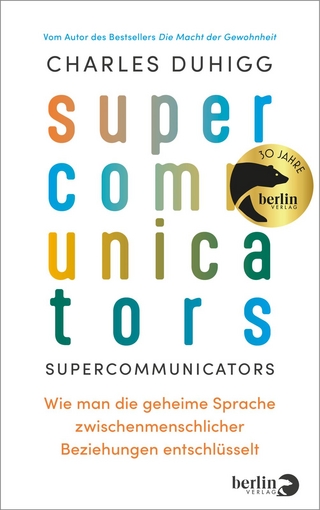
Public Speaking
Pearson (Verlag)
978-0-205-91463-0 (ISBN)
- Titel ist leider vergriffen;
keine Neuauflage - Artikel merken
An audience-centered approach to public speaking
Public Speaking: An Audience-Centered Approach, 9/e brings theory and practice together. Its distinctive and popular approach emphasizes the importance of analyzing and considering the audience at every point in the speech-making process. This model of public speaking is the foundation of the text, and it guides students through the step-by-step process of public speaking, focusing their attention on the dynamics of diverse audiences, and narrowing the gap between the classroom and the real world.
Teaching and Learning Experience
This program will provide a better teaching and learning experience—for you and your students. It:
Uses an Audience-Centered Approach: The audience-centered approach is the hallmark of this top selling text and the authors’ approach to public speaking.
Provides Material for Supporting First Speeches: Encourages students facing their first speech assignment by providing an overview of the public speaking process and suggestions for developing and delivering their speech with confidence.
Focuses on Skill Development: Learning Objectives, a Study Guide, Recap boxes and more help students check their understand of key material and focus on important concepts. .
Note: You are purchasing a standalone product; MyCommunicationLab does not come packaged with this content. If you would like to purchase both the physical text and MyCommunicationLab search for ISBN-10: 013381498X / ISBN-13: 9780133814989. This package includes: 0205890857 / 9780205890859 NEW MyCommunicationLab with Pearson eText -- Valuepack Access Card and 0205914632 / 9780205914630 Public Speaking: An Audience-Centered Approach
MyCommunicationLab is an integral part of the Beebe/Beebe program. With extensive opportunities for the application of course content, MyCommunicationLab helps students become better speakers and master key public speaking concepts. Interactive videos provide students with the opportunity to watch and evaluate sample speeches. Online self-assessments and pre- and post-tests help students assess their comfort level with public speaking and their knowledge of the material. MediaShare allows students to post speeches and share them with classmates and instructors.
ALERT: Before you purchase, check with your instructor or review your course syllabus to ensure that you select the correct ISBN. Several versions of Pearson's MyLab & Mastering products exist for each title, including customized versions for individual schools, and registrations are not transferable. In addition, you may need a CourseID, provided by your instructor, to register for and use Pearson's MyLab & Mastering products.
Packages
Access codes for Pearson's MyLab & Mastering products may not be included when purchasing or renting from companies other than Pearson; check with the seller before completing your purchase.
Used or rental books
If you rent or purchase a used book with an access code, the access code may have been redeemed previously and you may have to purchase a new access code.
Access codes
Access codes that are purchased from sellers other than Pearson carry a higher risk of being either the wrong ISBN or a previously redeemed code. Check with the seller prior to purchase.
Steven A. Beebe is serving in his 28th year as Chair, of the Department of Communication Studies at Texas State University. He is Regents’ and University Distinguished Professor of Communication Studies. He also served as Associate Dean of College of Fine Arts and Communication for 25 years. Steve is an author and co-author of twelve books (with multiple editions totaling more than 65 books), more than 50 articles and book chapters, as well as over 150 papers and presentations at professional conferences. Steve’s communication books have been used at hundreds of colleges and universities throughout the world making him one of the top communication textbook authors in the United States. Steve is President of the National Communication Association (NCA), the largest professional communication association in the world. Susan J. Beebe has been on the faculty of the Department of English at Texas State University-San Marcos since 1988. As Director of Lower-Division Studies in English, she directs the first-year writing and sophomore literature programs and helps to train and mentor some 60 graduate teaching assistants annually. Sue’s professional interests and expertise encompass both oral and written communication. She has co-authored with Steven Beebe several communication textbooks used at more than a thousand universities worldwide. In addition, she has published articles, conference papers, and teaching materials in both English and communication studies.
In this Section:
1. Brief Table of Contents
2. Full Table of Contents
1. Brief Table of Contents
Chapter 1: Speaking with Confidence
Chapter 2: Presenting Your First Speech
Chapter 3: Speaking Freely and Ethically
Chapter 4: Listening to Speeches
Chapter 5: Analyzing Your Audience
Chapter 6: Developing Your Speech
Chapter 7: Gathering and Using Supporting Material
Chapter 8: Organizing and Outlining Your Speech
Chapter 9: Introducing and Concluding Your Speech
Chapter 10: Using Words Well: Speaker Language and Style
Chapter 11: Delivering Your Speech
Chapter 12: Using Presentation Aids
Chapter 13: Speaking to Inform
Chapter 14: Understanding Principles of Persuasive Speaking
Chapter 15: Using Persuasive Strategies
Chapter 16: Speaking for Special Occasions and Purposes
Appendix A: Speaking in Small Groups
Appendix B: Speeches for Analysis and Discussion
2. Full Table of Contents
Chapter 1: Speaking with Confidence
What is Public Speaking?
Why Study Public Speaking?
The Communication Process
The Rich Heritage of Public Speaking
Improving Your Confidence as a Speaker
Chapter 2: Presenting Your First Speech
Consider Your Audience
Select and Narrow Your Topic
Determine Your Purpose
Develop Your Central Idea
Generate the Main Ideas
Gather Supporting Material
Organize Your Speech
Rehearse Your Speech
Deliver Your Speech
Chapter 3: Speaking Freely and Ethically
Speaking Freely
Speaking Ethically
Chapter 4: Listening to Speeches
Overcoming Barriers to Effective Listening
How to Become a Better Listener
Improving Listening and Critical Thinking Skills
Analyzing and Evaluating Speeches
Chapter 5: Analyzing Your Audience
Gathering Information about Your Audience
Analyzing Information about Your Audience
Adapting to Your Audience
Analyzing Your Audience before You Speak
Adapting to Your Audience as You Speak
Analyzing Your Audience after You Speak
Chapter 6: Developing Your Speech
Select and Narrow Your Topic
Determine Your Purpose
Develop Your Central Idea
Generate and Preview Your Main Ideas
Meanwhile, Back at the Computer . . .
Chapter 7: Gathering and Using Supporting Material
Sources of Supporting Material
Research Strategies
Types of Supporting Material
The Best Supporting Material
Chapter 8: Organizing and Outlining Your Speech
Organizing Your Main Ideas
Integrating Your Supporting Material
Organizing Your Speech for the Ears of Others: Signposting
Outlining Your Speech
Chapter 9: Introducing and Concluding Your Speech
Purposes of Introductions
Effective Introductions
Purposes of Conclusions
Effective Conclusions
Chapter 10: Using Words Well: Speaker Language and Style
Using Words Effectively
Adapting Your Language Style to Diverse Listeners
Crafting Memorable Word Structures
Chapter 11: Delivering Your Speech
The Power of Speech Delivery
Methods of Delivery
Characteristics of Effective Delivery
Audience Diversity and Delivery
Rehearsing Your Speech: Some Final Tips
Delivering Your Speech
Responding to Questions
Chapter 12: Using Presentation Aids
The Value of Presentation Aids
Types of Presentation Aids
Guidelines for Developing Presentation Aids
Guidelines for Using Presentation Aids
Chapter 13: Speaking to Inform
Types of Informative Speeches
Strategies to Enhance Audience Understanding
Strategies to Maintain Audience Interest
Strategies to Enhance Audience Recall
Developing an Audience-Centered Informative Speech
Chapter 14: Understanding Principles of Persuasive Speaking
The Goals of Persuasion
How Persuasion Works
How to Motivate Listeners
How to Develop Your Audience-Centered Persuasive Speech
Chapter 15: Using Persuasive Strategies
Enhancing Your Credibility
Using Logic and Evidence to Persuade
Using Emotion to Persuade
Strategies for Adapting Ideas to People and People to Ideas
Strategies for Organizing Persuasive Messages
Chapter 16: Speaking for Special Occasions and Purposes
Public Speaking in the Workplace
Ceremonial Speaking
After-Dinner Speaking: Using Humor Effectively
Appendix A: Speaking in Small Groups
Solving Problems in Groups and Teams
Participating in Small Groups
Leading Small Groups
Appendix B: Speeches for Analysis and Discussion
I Have a Dream, Martin Luther King Jr.
2013 Inaugural Address, Barack Obama
Duke University Commencement Address, Melinda Gates
You’re Not Special, David McCullough, Jr.
Elvis, Angelitta Armijo
| Erscheint lt. Verlag | 17.7.2014 |
|---|---|
| Sprache | englisch |
| Maße | 216 x 276 mm |
| Gewicht | 790 g |
| Themenwelt | Sachbuch/Ratgeber ► Beruf / Finanzen / Recht / Wirtschaft ► Briefe / Präsentation / Rhetorik |
| Schulbuch / Wörterbuch | |
| Geisteswissenschaften | |
| Sozialwissenschaften ► Pädagogik | |
| ISBN-10 | 0-205-91463-2 / 0205914632 |
| ISBN-13 | 978-0-205-91463-0 / 9780205914630 |
| Zustand | Neuware |
| Haben Sie eine Frage zum Produkt? |
aus dem Bereich


